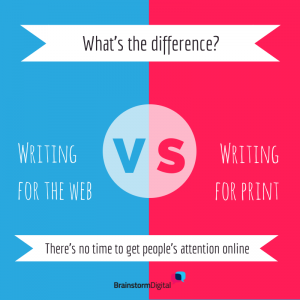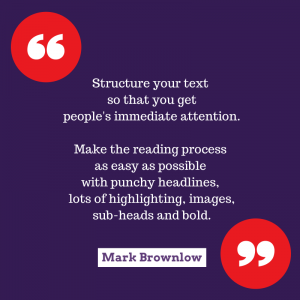 Do you regularly post content for your company online?
Do you regularly post content for your company online?
Are you not sure how writing for the web is different to writing for print?
Or how to make an immediate impact on your readers?
To learn how to create the most powerful copy for blogs, email marketing and social media, I spoke to Mark Brownlow, the tutor at Smart Insights’ very practical Online Copywriting Course.
He shared insights on:
- The best ways to structure your blog posts
- How to test whether your material works
- When you can write longer, and when you must cut, cut, cut
- The one crucial factor you must consider when writing headlines
and much more.
And as a special bonus, at the end of the interview, I’ve included his 10 tips for cutting down the length of your Tweets. Enjoy!
What’s the main difference between writing for the web and writing for print?
Mark Brownlow: The main difference is speed. There’s no time to get people’s attention online. People have a lot of alternatives – other emails, blog posts, Facebook entries – and you have to get their attention as soon as possible.
What are the practical implications for online copywriting?
People need to structure their text to get immediate attention. Offline, you can get away with a long paragraph of 20 lines, because the book is right in front of you. Online, you need to make the reading process as easy as possible with punchy headlines, lots of highlighting, images, sub-heads and bold.
Break the text up to allow people to see that it won’t take up as much energy as they think, and that they can find the information they need quickly. The key information or the product benefit has to be in the top paragraph, at the start of a headline, in the early part of a subject line (on email).
It’s critical – if you don’t do it, they’ll go elsewhere.
Why have so many people failed to adjust to this new way of writing?
Partially because the older generation has come out of an educational system that’s put a lot of emphasis on essay writing and print resources. People think that good writing means long paragraphs.
Also, lots of people transfer material from offline, such as handbooks, and put them online, assuming it’s good enough – which it isn’t.
Writing short-form takes time. It’s easier to write lengthier, more verbose text – ironically! It reminds me of the quote by Blaise Pascal – “I would have written a shorter letter, but I didn’t have the time”.
What is people’s biggest mistake writing online?
Not understanding that you’re not writing for yourself, but for your visitor, and their interests are not necessarily yours.
People often write for themselves, their manager or their colleague. Their needs do need to flow into the text, but at the end of the day, it’s about the reader.
They should not just be talking about their products’ features, but about their benefits. Where’s the value? When you talk about ‘battery capacities’, what does that actually mean to someone outside your industry? It’s classic video instructions. No one has a clue what you’re writing about.
Is there a point writing long-form for the web any more?
There are some decisions people need to take that require a lot of persuasion or information. Before I buy nutritional supplements for my kids, I will need to know a lot about it – I want evidence and testimonials. There are also lots of scenarios where you might need long pieces for complicated purchases.
What’s more of a personal issue for me is, where information is getting shorter and shorter, it’s very difficult to express real depth of understanding or expertise if every blog posts is 200 words.
Lots don’t need the depth, but if you’re a professional services business, there is still a role for demonstrating your expertise. Not everyone will read it, but maybe those you’re trying to convince will.
In your course, you talk about testing your material. Do you make changes immediately?
There’s a double edge to it. I often test before something is implemented for the first time. If I have a choice of two different texts, I’ll put both up, A/B test them, and then the winner goes full-time. I might test whether users click the buy button or how long they spend on the page.
The other side is designing a test that tells you something about your audience that you can use later, for example subject line testing on emails. What words do they react best to?
You need to repeat tests – the people and even the results can change.
Email lends itself naturally to testing because you get result quickly, but the results can be used on website copy as well. Google’s Analytics has this function built in.
When everyone is using the same tricks to attract audiences – like using lists and promising ‘tips you can’t miss’ – how do you stand out?
You have to be careful not to get sucked into the idea that all that matters is the number of clicks and retweets. Unless your only objective in life is to get as many RTs as possible, it’s not what you want.
Look deeper. If people are retweeting you but not reading the piece, or if they’re not your target audience, the retweets don’t matter so much. You can use lots of [blogs titled] “7 different ways” or “10 reasons why”, and gets lots of traffic, but you need to mix it up as well.
I advise to use these tricks, but don’t just go that route. Don’t just focus on retweets, think of the overall impact of your last 10 blog posts. If they all sound formulaic, there’s a danger people will think you’re starting to sound like everyone else. Especially with adjectives like ‘Fabulous’, ‘marvellous’ – if you’re not delivering, your credibility will suffer.
The actual quality of what you write will determine your long-term success.
What is the impact of mobile on online writing?
People talk about attention getting even tighter, but people are also using mobile for downtime, on the train when they have two hours to kill.
From an email perspective, you need to do everything you’re doing for the web, but more so. It’s intensified copywriting needs. Cut out all waffle, secondary and uninteresting material. Make sure the really critical stuff is there.
There are lots of bookmarks and emails to read – you have to make it as easy and attractive as possible to stick with you. It’s not a big screen, reading isn’t that comfortable. Shorten your headlines and paragraphs.
How can copy be shaped most effectively in tweets?
You need to leave enough space for retweets, so that people can add their own comments. Invest time in cutting.
The real trick is to make sure that your blog post headline is tweetable. Because most content now is repurposed, think about tweeting or your Facebook posts as you write the post itself and its title. It’s easier to tweet and for other people to tweet your material as well.
Make it easy for them – if they have to think about how to make your title retweetable, it reduces the chance they’ll do so.
Mark’s Top 10 tips for shortening your tweets
1. Rewrite. Don’t settle for your first Tweet draft. Work on it!
2. Use synonyms. Look up alternatives for long words.
3. Eliminate implied and suggested words like ‘I’ and ‘That’
4. Replace words with symbols and numbers. Instead of ‘and’ use &; Fourteen should be 14 etc.
5. Write in the active voice. Not ‘are using’ but ‘use’, not ‘I’m planning to’ but ‘I plan’
6. Use hashtags for context. For example, instead of explaining that ‘This tip is for Pharmaceutical marketers’, simply add the hashtag #Pharmamktg at the end
7. Use abbreviations. For example can be shortened to ‘eg’….
8. Use short URLs. Hootsuite will shorten your URLs for you, otherwise use ow.ly or bit.ly or a similar service
9. Trailing dots. Instead of writing a whole list, use ….. to imply there’s more. For example, “Tips on copywriting, email marketing, social media….”
10. Use questions instead of full sentences. For example, instead of “Attention, copywriters!”, you can write: “Copywriter?”
Mark Brownlow is an email copywriter, business writer and lecturer.
Smart Insights’ Online Copywriting Course, which he tutors, is a 3-hour course designed to help you improve your online copy, from web to social media to email marketing.
Miriam Shaviv is director of content at Brainstorm Digital.
Do you have any tips for writing well for the web? Please share them in the comments!








